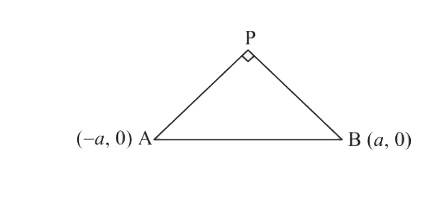A and B are two fixed points. The vertex C of a ΔBC moves such that cotA+cotB= constant. Locus of C is a straight line
⊥ to AB
parallel to AB
Inclined at an angle of A−B to AB
none
The correct Answer is:B
To solve the problem, we need to find the locus of point C in triangle ABC, where A and B are fixed points, and the condition given is that cotA+cotB=constant.
1. Understanding the Triangle:
Let A and B be two fixed points in the Cartesian plane. Let C be a point that moves such that the sum of the cotangents of angles A and B is a constant.
2. Define the Angles:
Let ∠ACB=C, ∠ABC=B, and ∠BAC=A.
3. Using Cotangent Definitions:
The cotangent of an angle in a triangle can be expressed in terms of the lengths of the sides:
- cotA=ADCD
- cotB=BDCD
where D is the foot of the perpendicular from C to line AB.
4. Setting Up the Equation:
Given that cotA+cotB=constant, we can write:
cotA+cotB=ADCD+BDCD=AD+BDCD
This implies:
AD+BDCD=constant
5. Finding the Locus:
Since AD+BD=AB (the sum of the segments from D to A and B is equal to the length of AB), we can substitute:
ABCD=constant
Let’s denote AB=K, where K is a constant.
6. Conclusion About the Locus:
Rearranging gives us:
CD=Kconstant
Since K is constant and the denominator is also constant, CD must be a fixed value. This means that as C moves, the height from C to line AB (which is represented by CD) remains constant.
7. Final Result:
Therefore, the locus of point C is a straight line parallel to line AB.
Let A and B be two fixed points in the Cartesian plane. Let C be a point that moves such that the sum of the cotangents of angles A and B is a constant.
Let ∠ACB=C, ∠ABC=B, and ∠BAC=A.
The cotangent of an angle in a triangle can be expressed in terms of the lengths of the sides:
- cotA=ADCD
- cotB=BDCD
where D is the foot of the perpendicular from C to line AB.
Given that cotA+cotB=constant, we can write:
cotA+cotB=ADCD+BDCD=AD+BDCD
This implies:
AD+BDCD=constant
Since AD+BD=AB (the sum of the segments from D to A and B is equal to the length of AB), we can substitute:
ABCD=constant
Let’s denote AB=K, where K is a constant.
Rearranging gives us:
CD=Kconstant
Since K is constant and the denominator is also constant, CD must be a fixed value. This means that as C moves, the height from C to line AB (which is represented by CD) remains constant.
Therefore, the locus of point C is a straight line parallel to line AB.
Topper's Solved these Questions
- RECTANGULAR CARTESIAN CO-ORDINATE SYSTEM AND THE STRAIGHT LINEBOOK - ML KHANNACHAPTER - RECTANGULAR CARTESIAN CO-ORDINATE SYSTEM AND THE STRAIGHT LINEEXERCISE - PROBLEM SET(2)(TRUE AND FALSE)
7 Videos
- RECTANGULAR CARTESIAN CO-ORDINATE SYSTEM AND THE STRAIGHT LINEBOOK - ML KHANNACHAPTER - RECTANGULAR CARTESIAN CO-ORDINATE SYSTEM AND THE STRAIGHT LINEEXERCISE - PROBLEM SET(2)(fill in the blanks)
2 Videos
- RECTANGULAR CARTESIAN CO-ORDINATE SYSTEM AND THE STRAIGHT LINEBOOK - ML KHANNACHAPTER - RECTANGULAR CARTESIAN CO-ORDINATE SYSTEM AND THE STRAIGHT LINEEXERCISE - PROBLEM SET(1)(FILL IN THE BLANK)
3 Videos
- PROPERTIES OF TRIANGLES BOOK - ML KHANNACHAPTER - PROPERTIES OF TRIANGLES EXERCISE - Self Assessment Test (Multiple Choise Questions)
34 Videos
- SELF ASSESSMENT TEST BOOK - ML KHANNACHAPTER - SELF ASSESSMENT TEST EXERCISE - OBJECTIVE MATHEMATICS
16 Videos
Similar Questions
Knowledge Check
A and B are two fixed points. The vertex C of triangle ABC moves such that cotA+cotB= constant. The locus of C is a straight line
 Aperpendicular to ABBparallel to ABCinclined at an angle (A−B) to ABDNone of these
Aperpendicular to ABBparallel to ABCinclined at an angle (A−B) to ABDNone of theseA and B are two fixed points. The locus of a point P such that ∠APB is a right angle, is:
 Ax2+y2=a2Bx2−y2=a2C2x2+y2=a2DNone of these
Ax2+y2=a2Bx2−y2=a2C2x2+y2=a2DNone of theseLet A(2,0)andB(−2,0) are two fixed vertices of ΔABC. If the vertex C moves in the first quadrant in such a way that cotA+cotB=2, then the locus of the point C is
Ay=2Bx=4Cx=2Dy=1
A and B are two fixed points. The locus of P such that in ΔPAB,sinBsinA is a constant is (≠1)
View SolutionIf A and B are two fixed points, then the locus of a point P, such that ∠APB=90∘? is _______
View SolutionA variable straight line is drawn from a fixed point O meeting a fixed circle in P and a point Q is taken on this line such that OP.OQ is constant, then locus of Q is : (A) a straight line (B) a circle (C) a parabola (D) none of these
View SolutionIn triangle ABC, base BC is fixed. Then prove that the locus of vertex A such that tan B+tan C= Constant is parabola.
View SolutionIf a ΔABC remains always similar to a given triangle and the point A is fixed and the point B always moves on a given straight line, then locus of C is (A) a circle (B) a straight line (C) a parabola (D) none of these
View Solution
